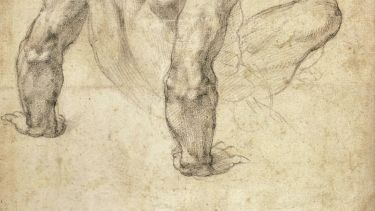Bee-stung lips: Blazoning the male body in sixteenth-century print
Professor Cathy Shrank delves into the work of Elizabethan poet Richard Barnfield, who she believes deserves a wider audience.

The Elizabethan poet Richard Barnfield isn’t widely known today, but – for a brief period, between 1594-1598 – he was a prolific and significant poet: his poetry was included in early seventeenth-century anthologies; his sonnets almost certainly influenced Shakespeare’s; and the eighteenth-century literary historian Thomas Warton would later call him ‘an author of such undoubted genius’.
Warton also notes that ‘the subject and groundwork’ of some of Barnfield’s poetry is ‘open to exception’: it is a ‘somewhat delicate task,’ he continues, ‘to select a specimen which will afford a fair idea of Barnfield’s style and abilities, without introducing allusions of an equivocal tendency’. Warton doesn’t state outright what he means here, but it was certainly the blatantly homoerotic content of Barnfield’s The Affectionate Shepherd (1594), which contains ‘The Complaint of Daphnis for the Love of Ganymede’, a story of unrequited passion that continues in ‘Certain Sonnets’, printed in Barnfield’s second volume of poetry in 1595 (a sequence which Warton chooses to pass over silently). The names of both protagonists signal same-sex attraction: Daphnis, the legendary inventor of pastoral poetry, was the lover of the god Pan; Ganymede was the beautiful shepherd boy abducted by Zeus/Jupiter (infamous for his ever-wandering eye) to become the cupbearer to the gods.
‘The Complaint’ opens with Daphnis ‘cursing the time, the place, the sense, the sin’ into which he has ‘slipped’ since Ganymede has his ‘heart entangled’, although we soon find Daphnis querying whether such desire is immoral after all. ‘If it be sin to love a sweet-faced boy,’ he qualifies, before committing whole-heartedly to that emotion: ‘If it be sin to love a lovely lad,/ Oh, then sin I.’ And this is this is no cerebral infatuation. Daphnis longs for physical consummation, as can be seen in the innuendo-laden lines in which Daphnis imagines his ‘lips were honey’ and Ganymede’s ‘mouth a bee’: ‘Then should thou suck my sweet and my fair flower/ That now is ripe, and full of honey-berries’.
Homosexual acts – such as the fellatio invoked here – did not merely run counter to sixteenth-century moral norms (as revealed by Daphnis’ use of the language of sin), they were also illegal. Nevertheless, Barnfield’s poems appeared in print: they did not circulate in manuscript, like much erotic writing in this period. Nor were they covert publications. There is no attempt to disguise who is responsible for their publication, as would be the case for illicitly printed works. The printer (John Danter) is named on the title-page of the first volume; the publisher and book-seller Humphrey Lownes on the second.
The Affectionate Shepherd doesn’t name its author, but signing the dedicatory poem with the name ‘Daphnis’ aligns the poet with the ‘affectionate shepherd’ who yearns for another man. Barnfield doesn’t distance himself from the persona Daphnis, in other words, and he went on to claim authorship of The Affectionate Shepherd in his second collection, printed the following year. In that volume, in the address ‘To the courteous gentlemen readers’, Barnfield insists that ‘The complaint of Daphnis’ is ‘nothing else, but an imitation of Virgil’, authorising the expression of same-sex desire through evoking the precedent of Eclogue 2 by the Roman poet Virgil, in which the shepherd Corydon burns with love for ‘fair Alexis’.
Nonetheless, that justification rings pretty hollow. Mentioning ‘The complaint’ and linking it with a well-known expression of same-sex love would seem to be more about drawing attention to its homoerotic content than explaining it away. Moreover, if Barnfield’s intentions in writing ‘The complaint’ had been misread, why go over the same ground in a form – the sonnet – strongly associated with unrequited love/desire, and which, as a more contemporary form, cannot be excused as an imitation of the foremost Latin poet? And despite the abundance of classical references, the narrative of ‘Certain Sonnets’ plays out against a decidedly Elizabethan backdrop. Ganymede skinny-dips in the Thames (Sonnet 7); Daphnis carries an array of voguish sixteenth-century accessories: a mirror case (Sonnet 11), ‘a milk-white cheverel [kid leather] glove’ (Sonnet 14).
Barnfield’s sonnet sequence matches ‘The complaint’ in its frank expression of same-sex desire. The blazon, cataloguing the physical attractions of the female beloved, is a staple feature of sixteenth-century amorous verse. (Shakespeare famously parodies this poetic trope in Sonnet 130, ‘My mistress’ eyes are nothing like the sun’.) Such blazons – in which the woman’s body parts are compared to various precious but inanimate objects – are usually dominated by the sense of sight, with some attention paid to hearing and smell. These are all senses which can operate at varying degrees of distance; the poetic speakers can conceptualise seeing the beloved, perhaps hearing her, or catching a whiff of scent, but they don’t imagine getting any closer than that. Barnfield’s sonnets, in contrast, envisage Ganymede’s body as something to touch and taste: ‘His lips ripe strawberries in nectar wet;/ His mouth a hive; his tongue a honeycomb’ (Sonnet 17). Those bees again: the image is borrowed from the Song of Songs, a bizarrely erotic section of the Bible, traditionally attributed to King Solomon. The lines don’t simply tell us what Ganymede’s lips look like (full and red), but what they might taste and feel like (sweet, wet).
As in The Affectionate Shepherd, with its allusion to oral sex, there’s a physicality to Daphnis’ articulation of desire. ‘One night I dreamed (alas, ’twas but a dream)/ That I did feel the sweetness of the same,’ he recalls, remembering a vision of Ganymede’s lips:
Therewith inspired, I young again became
That from my heart a spring of blood did stream.
[…]
Then if in dreaming so, I so did speed,
What should I do, if I did so indeed? (Sonnet 6)
‘Speed’ is an Elizabethan synonym for ‘ejaculate’, and early-modern medical theory held that semen was thickened (‘concocted’) blood.
Barnfield’s sonnets are sexually explicit, particularly once you understand early-modern sexual idiom, but they also have a lightness of touch and beautiful modulation of tone. His manipulation of the sonnet form is skilful, deploying enjambment and mid-line caesura to avoid strings of end-stopped lines that can make some sixteenth-century sonnets clunky, whilst his frequent use of unstressed rhymes further softens the line-endings. ‘Oh, how can such a body sin-procuring/ Be slow to love, and quick to hate enduring?’ asks Daphnis at the conclusion of Sonnet 17, the double-rhyme (-uring) and extra eleventh syllable extending both the lines and Daphnis’ regretful yearning, so that the sound of the poem fades, rather than ending on a chiming pair of monosyllables.
Elsewhere, Barnfield uses the fourteen-line form of the sonnet to show perfect comic timing. Sonnet 11 finds Ganymede quizzing Daphnis on the identity of the person for whom he is clearly pining. Ganymede – who is clearly none-too-observant – assumes that this is a woman. Barnfield withholds until the final two lines the revelation to Ganymede that he, not some female beauty, is the one for whom Daphnis sighs:
‘And what is she,’ quoth he, ‘whom thou does love?’
‘Look in this glass,’ quoth I, ‘there shalt thou see
The perfect form of my felicity.’
When, thinking it that it would strange magic prove,
He opened it: and taking off the cover,
He straight perceived himself to be my lover.
The sonnet ends; we are left to imagine Ganymede’s reaction.
Barnfield is one of my absolute favourite sixteenth-century sonneteers. And, as someone who edited Shakespeare’s Poems, believe me: I’ve read an awful lot of sonnets. So, give Barnfield a go: he deserves a wider audience.
Follow Cathy on Twitter: @cathy_shrank


